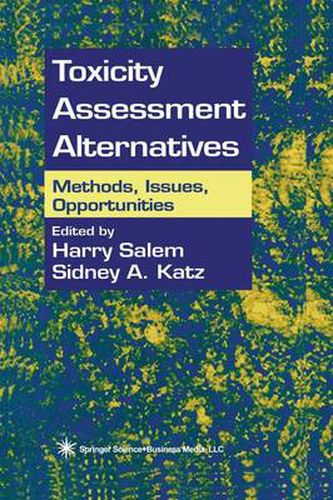Readings Newsletter
Become a Readings Member to make your shopping experience even easier.
Sign in or sign up for free!
You’re not far away from qualifying for FREE standard shipping within Australia
You’ve qualified for FREE standard shipping within Australia
The cart is loading…






This title is printed to order. This book may have been self-published. If so, we cannot guarantee the quality of the content. In the main most books will have gone through the editing process however some may not. We therefore suggest that you be aware of this before ordering this book. If in doubt check either the author or publisher’s details as we are unable to accept any returns unless they are faulty. Please contact us if you have any questions.
Toxicity Assessment Alternatives: Methods, Issues, Opportunities contains a broad array of critical surveys, contributed by active and respected investigators, describing their research and offering updates on toxicity assessment alternatives, directions determined by current and future grant programs, opportunities for mechanistically based test methods to detect endocrine disruptor activity, the use of alternatives in the Department of Defense hazard assessment initiatives, and the issues and opportunities for validation and regulatory acceptance. Several of these advances make use oftransgenic models that reduce the time and cost of carcinogenicity testing. Others use tissue cultures for the assessment of endocrine disrupting chemicals. Cultures of human epidermal keratinocytes are applicable as models for sulfur mustard lesions, and in vitro protein denaturation is used as a chemical test for assessing the ocular and dermal irritation potential of cosmetic prod ucts. Molecular modeling is applied to explaining chemical toxicity. Commercially developed assay systems have undergone extensive evaluation by their manufacturers. Some of these await external valida tion, and others await acceptance by North American and European regulatory agencies. Toxicity Assessment Alternatives: Methods, Issues, Opportunities provides information from members of the scientific and regulatory communities on what has been achieved and what has been accepted in alternatives to animal testing.
$9.00 standard shipping within Australia
FREE standard shipping within Australia for orders over $100.00
Express & International shipping calculated at checkout
This title is printed to order. This book may have been self-published. If so, we cannot guarantee the quality of the content. In the main most books will have gone through the editing process however some may not. We therefore suggest that you be aware of this before ordering this book. If in doubt check either the author or publisher’s details as we are unable to accept any returns unless they are faulty. Please contact us if you have any questions.
Toxicity Assessment Alternatives: Methods, Issues, Opportunities contains a broad array of critical surveys, contributed by active and respected investigators, describing their research and offering updates on toxicity assessment alternatives, directions determined by current and future grant programs, opportunities for mechanistically based test methods to detect endocrine disruptor activity, the use of alternatives in the Department of Defense hazard assessment initiatives, and the issues and opportunities for validation and regulatory acceptance. Several of these advances make use oftransgenic models that reduce the time and cost of carcinogenicity testing. Others use tissue cultures for the assessment of endocrine disrupting chemicals. Cultures of human epidermal keratinocytes are applicable as models for sulfur mustard lesions, and in vitro protein denaturation is used as a chemical test for assessing the ocular and dermal irritation potential of cosmetic prod ucts. Molecular modeling is applied to explaining chemical toxicity. Commercially developed assay systems have undergone extensive evaluation by their manufacturers. Some of these await external valida tion, and others await acceptance by North American and European regulatory agencies. Toxicity Assessment Alternatives: Methods, Issues, Opportunities provides information from members of the scientific and regulatory communities on what has been achieved and what has been accepted in alternatives to animal testing.